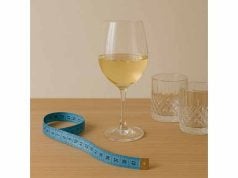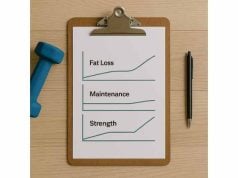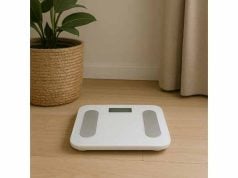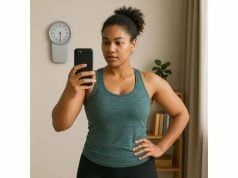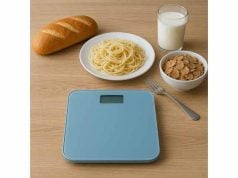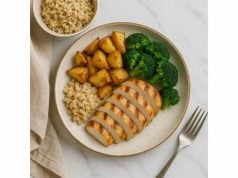
Hot flashes get attention, but the quiet change many women notice first is stalled progress. Your meals look the same, steps are similar, yet the scale barely moves and waistlines feel stubborn. Perimenopause and midlife bring real shifts in sleep, appetite, recovery and where your body prefers to store energy. The fix is not to double down on restriction; it is to update your playbook so your plan works with changing physiology. In this guide you will learn how to confirm a true stall, set macros you can live with, train for strength and recovery, and manage sleep and stress so progress returns. If you need a fast diagnostic before you adjust anything, try our concise plateau troubleshooting guide to separate normal noise from a genuine plateau.
Table of Contents
- Perimenopause plateaus explained
- How to reset your baseline
- Macros and meals that work
- Training that respects recovery
- Sleep, stress and hot flashes
- When hormones or meds are involved
- Progress checks and expectations
- FAQ
Perimenopause plateaus explained
Perimenopause is a transition, not a switch. Across several years, estrogen and progesterone fluctuate, menstrual cycles become less predictable, and recovery from poor sleep or stress gets slower. None of this “locks” fat loss, but it changes how progress shows up and what type of plan you can repeat through busy weeks.
What typically drives midlife stalls:
- Sleep fragmentation. Night sweats and early waking erode deep sleep. Poor sleep increases appetite signals, lowers restraint, and makes evening snacking more likely.
- Recovery lag. The same training that felt fine at 35 can create more soreness at 45. When recovery slips, incidental movement (NEAT) falls and overall expenditure drops.
- Protein and muscle signal. You can still build and maintain muscle, but protein distribution matters more. Spread 25–40 g across meals to counter “anabolic resistance.”
- Water and sodium shifts. Cycle variability, hot flashes, and changing activity patterns affect fluid balance. The scale can look stuck even when measurements improve.
- Stress load. Work, caregiving, and life logistics crowd out movement and consistent meals—especially on weekends.
What doesn’t help:
- Chasing the scale with extra cardio while sleep is poor.
- Slashing calories so hard that hunger, cravings and training intensity collapse.
- Switching plans every week and never giving changes time to work.
A better approach is to confirm you are in a true plateau, then adjust inputs—sleep, NEAT, protein timing, training structure, and realistic calories—so your body has reasons to cooperate. If you need a refresher on the basics of energy balance before you tune your plan, skim our primer on safe weight-loss basics.
Key takeaway: Midlife physiology rewards consistency, protein timing, and recovery-aware training. Get those right and progress returns—often without extreme restriction.
How to reset your baseline
Before you overhaul your diet, verify the stall and reset the pieces that drift most in midlife: weighing, steps, and evening intake. This takes two weeks and prevents “plan hopping.”
1) Confirm a true plateau with matched weeks
- Weigh every morning after bathroom, before food.
- Compute 7-day averages.
- Compare Week 1 vs. Week 2. A change under ~0.25–0.5% of body weight often means maintenance, not failure.
- If your cycle is irregular, compare weeks with similar sleep and sodium patterns.
2) Make your movement visible
- Track steps all day for two weeks.
- Record the longest seated block.
- Note errands, stairs, and chores (yes/no).
- Set a floor/ceiling band (e.g., 7,000–11,000 steps) so hard days count as success when you defend the floor.
3) Audit evenings
Many midlife stalls happen after 7 p.m. because hunger, habit, and fatigue converge. For seven nights, log what you plan to eat after dinner and what you actually eat. You’re not forcing perfection—just building visibility.
4) Re-establish protein and fiber timing
- Protein: 1.6–2.2 g/kg/day, spread across 3–5 meals, 25–40 g per meal.
- Fiber: 25–40 g/day with 8–12 g at dinner to calm late hunger.
5) Set one target change
Pick the lever with the biggest return: post-meal walks, a planned night snack, or a fixed lunch. Hold it for 14 days before changing anything else.
If you want a structured framework to confirm the stall and decide your next lever, use our simple two-to-four week check. It prevents overreacting to water or one tough week.
Bottom line: Do the boring setup once: trend weights, defend a step floor, and fix the evening plan. That baseline turns “I feel stuck” into a clear, actionable picture.
Macros and meals that work
The goal at midlife is not a fancy ratio; it is satiating meals you can repeat that protect muscle, support training, and keep evenings calm.
Protein is the anchor
Aim for 1.6–2.2 g/kg/day. Older trainees benefit from the higher end, with 25–40 g per meal to stimulate muscle repair. Practical anchors: Greek yogurt, cottage cheese, eggs, tofu, tempeh, fish, poultry, lean meats, skyr, seitan.
Carbs are the throttle
Carbohydrates support training and mood. Keep 20–50 g around workouts and dinner if evenings are your hard time. Choose potatoes, rice, oats, whole-grain pasta, legumes, fruit. You can pull carbs a bit lower on sedentary days, but keep enough for good training.
Fats are the stabilizer
Hold a floor around 0.6–1.0 g/kg/day from olive oil, nuts, seeds, avocado, and dairy. If cravings improve with richer meals, shift 10–15 g fat to dinner and trim carbs equivalently.
Fiber and volume
Target 25–40 g/day through vegetables, fruit, legumes and whole grains. Add 8–12 g at dinner to lower late snacking. High-volume choices—berries, leafy salads, broth-based soups, potatoes—make maintenance-level meals feel generous.
Two sample days (about 2,100–2,400 kcal—scale as needed)
- Training day
- Breakfast: Greek yogurt (300 g), berries, 30 g muesli.
- Lunch: Lentil-chicken bowl (150 g chicken, 1 cup lentils, greens, salsa).
- Snack (pre-workout): Banana + whey or soy shake.
- Dinner: Salmon (150–180 g), potatoes (250 g), broccoli, olive oil.
- Night: Cottage cheese (200 g) with cinnamon.
- Desk-heavy day
- Breakfast: Tofu scramble + whole-grain toast.
- Lunch: Turkey or tempeh salad wrap, apple.
- Snack: Skyr or soy yogurt.
- Dinner: Bean chili, rice, mixed salad with vinaigrette.
- Night (if needed): Casein shake or skyr.
For more detail on translating calories into a macro split that actually keeps you satisfied, see our practical overview of maintenance macros and meal building.
Bottom line: Build meals with a protein anchor, fiber volume, and smart energy. Evening calm comes from earlier structure, not from white-knuckling 9 p.m.
Training that respects recovery
You do not need “more exercise”; you need the right dose that builds or preserves muscle while leaving energy for life. Recovery-aware training pairs best with midlife physiology and busy calendars.
Strength training first
Two to four full-body sessions per week, 45–60 minutes, built around:
- Squat pattern (squat or leg press)
- Hinge pattern (deadlift or hip hinge)
- Push (bench or push-up)
- Pull (row or pull-down)
- Carry or core (farmer carry, plank)
Choose loads you can move for 5–12 reps with 1–3 reps in reserve most sets. Progress by adding a rep, a little weight, or an extra set across weeks.
Cardio that complements, not competes
Use easy to moderate cardio for 20–40 minutes on 2–3 days: brisk walking, cycling, swimming. Keep one day with short intervals if you enjoy them, but avoid stringing together hard sessions that wreck sleep and NEAT.
NEAT (daily movement) is your silent ally
Defend a step floor and embed 3×10-minute post-meal walks. This supports appetite, mood, and glucose handling without stealing recovery. For a detailed blueprint, see our straightforward daily movement plan.
Signs your plan is too much
- You lose reps or loads for two weeks.
- You dread sessions you used to enjoy.
- You sit more after workouts and steps fall.
- Sleep gets choppy.
If strength is sliding
- Add 20–40 g carbs within three hours before lifting or to dinner the night before morning sessions.
- Add one extra rest day this week.
- Keep sets hard enough to matter, short enough to recover.
Bottom line: Prioritize high-quality lifts, easy movement, and consistent sleep. The combination keeps muscle signal high and stress manageable—exactly what midlife bodies respond to.
Sleep, stress and hot flashes
Sleep quality drives appetite, mood, and recovery. In perimenopause, sleep fragmentation and vasomotor symptoms (hot flashes, night sweats) are common. Tightening your evening routine and cooling the bedroom often pay off faster than cutting calories again.
Evening routine that protects sleep
- Set a wind-down window (45–60 minutes). Dim lights, stretch, light reading, and reduce news and intense shows.
- Keep caffeine early—last dose 8 hours before bed.
- Limit alcohol on weeknights; it fragments sleep and worsens night sweats.
- Close the kitchen 60–90 minutes before bed; choose a small, protein-forward snack if needed.
Bedroom environment
- Cool the room (16–19°C / 60–67°F).
- Use breathable bedding and keep a small fan near the bed.
- Keep a water bottle and light robe or towel handy for quick changes after night sweats.
Daytime choices that improve nights
- Get morning light exposure for 10–20 minutes.
- Stick to regular meal times to stabilize appetite signals.
- Schedule walk-and-talk calls to reduce afternoon slump and screen fatigue.
If sleep debt is part of your plateau, our step-by-step guide to sleep and stalled fat loss shows how to repair recovery without derailing your calendar.
Bottom line: Better sleep and cooler nights lower cravings, reduce late-evening grazing, and restore training drive—three levers that move the scale more than another cardio session.
When hormones or meds are involved
Some midlife stalls have medical contributors. The goal is not to self-diagnose but to bring clear data to your clinician so you can choose the best plan together.
When to seek a review
- Periods become very heavy or extremely irregular for several months.
- You experience rapid fluid shifts, persistent swelling, or shortness of breath.
- Mood symptoms escalate or sleep becomes chronically fragmented.
- You started a new medication and appetite or energy changed sharply.
Hormone therapy (HT)
HT can be appropriate for symptom relief in selected individuals. It’s not a primary fat-loss tool, but by improving sleep and vasomotor symptoms it may support consistency and training. Your clinician will weigh benefits and risks based on your history.
Medications and weight
Some prescriptions influence appetite, energy or water retention. Do not stop or change any medication without guidance. Arrive with two weeks of morning weights, step averages, evening intake notes, and a short timeline of when changes began. For a patient-friendly overview of common culprits and discussion points, review our medication review checklist before your appointment.
Conversations to have
- Are there weight-neutral options within my current medication class?
- Would timing (morning vs. night), extended-release forms, or slower titration reduce side effects?
- If we stay with this plan, what nutrition and activity guardrails do you recommend?
Bottom line: If medical factors are in play, coordinate early. Safe symptom control and a simple, repeatable plan beat a perfect plan you cannot sustain.
Progress checks and expectations
Progress at midlife tends to be slower and steadier—and that is fine. Set expectations correctly and plateaus become a prompt to adjust inputs, not a verdict on your effort.
How to judge change
- Weight: Compare two 7-day averages at similar sleep and sodium patterns. Aim for 0.3–0.7% body weight change per week when actively cutting; flat lines during maintenance weeks are a win.
- Measurements and photos: Waist or navel measurements weekly; photos twice per month in similar light.
- Strength and steps: Lifts hold or improve slowly; step floor is defended most days.
When the scale is noisy
- Check sodium consistency.
- Scan for late-luteal water if cycles continue; judge again 3–5 days after bleeding starts.
- Confirm that NEAT hasn’t slipped below your floor.
Decision tree (every 14 days)
- If weight and waist trend down and you feel good: stay the course.
- If weight is flat, waist trends down, training improves: you might be recomping—keep protein and lifting steady.
- If weight and waist are flat and evenings feel hungry: shift 10–20 g protein and 8–12 g fiber to dinner; pre-plan a 150–250 kcal night snack.
- If steps and lifts are falling: consider a 10–14 day diet break at maintenance or a small 100–200 kcal bump and reassess.
If you focus more on fit and photos than the scale, our quick guide to tracking body recomposition can help you choose the right metrics for your goal.
Bottom line: Progress is the trend plus how you feel, not a single weigh-in. Review every two weeks, change one lever at a time, and give your plan room to work.
FAQ
Why does fat loss feel harder in perimenopause?
Fluctuating hormones fragment sleep, shift appetite and cravings, and slow recovery. You move less without noticing and tolerate less training volume. The fix is better sleep hygiene, a defended step floor, protein at each meal, and recovery-aware strength training, not extreme calorie cuts.
How much protein should I eat at midlife?
Aim for 1.6–2.2 g/kg/day, spread across 3–5 meals with 25–40 g per meal. The higher end helps counter age-related reductions in muscle protein synthesis and improves satiety, which steadies evenings and makes a deficit easier to maintain.
What training split works best now?
Two to four full-body strength sessions per week plus 2–3 easy cardio days and daily movement anchors. Keep most sets 1–3 reps from failure and progress gradually. Avoid stacking hard workouts that ruin sleep and reduce NEAT the rest of the day.
Should I lower carbs in midlife?
You can, but prioritize protein and fiber first. Keep 20–50 g carbs around training and dinner if evenings are tough. If richer meals curb cravings, shift 10–15 g fat to dinner and reduce carbs equivalently while keeping total calories aligned with your goal.
How do I handle night sweats and sleep disruption?
Cool the bedroom (16–19°C), use breathable bedding, and keep a fan and water nearby. Move caffeine earlier, limit alcohol on weeknights, and build a 45–60 minute wind-down routine. Short post-meal walks and consistent bedtimes improve sleep quality and next-day appetite control.
When should I talk with my clinician?
If periods become very heavy or irregular for months, symptoms escalate, or you see rapid water retention, seek care. Also review new medications that may affect appetite or energy, and discuss options or timing strategies that support your weight and training goals.
References
- The 2022 hormone therapy position statement of The North American Menopause Society 2022 (Guideline)
- The 2023 nonhormone therapy position statement of The North American Menopause Society 2023 (Guideline)
- International society of sports nutrition position stand: nutritional concerns of the female athlete 2023 (Position Statement)
- Critical variables regulating age-related anabolic responses to protein nutrition in skeletal muscle 2024 (Review)
- After Dinner Rest a While, After Supper Walk a Mile? A Systematic Review with Meta-analysis on the Acute Postprandial Glycemic Response to Exercise Before and After Meal Ingestion in Healthy Subjects and Patients with Impaired Glucose Tolerance 2023 (Systematic Review & Meta-analysis)
Disclaimer
This article offers general education about perimenopause, midlife physiology, nutrition, and activity. It is not medical advice and does not replace guidance from a qualified clinician. If you have significant bleeding changes, severe symptoms, medical conditions, or new medications, seek personalized care before altering your diet or training.
Share and follow
If this guide helped you understand midlife plateaus, consider sharing it with a friend who is navigating the same season. For practical checklists and future updates, follow us on the social platform you use most—Facebook, X (formerly Twitter), or another network you prefer.

